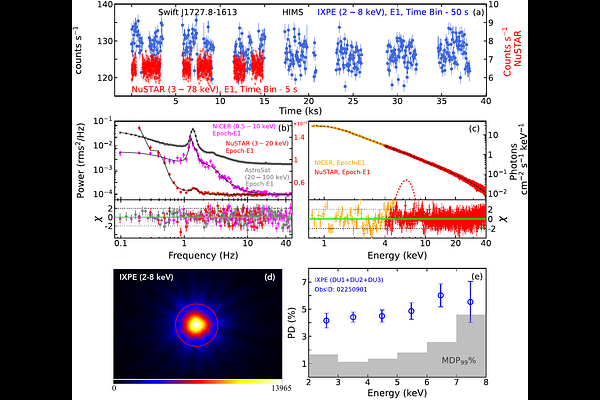Probing the accretion geometry of black hole X-ray binaries: A multi-mission spectro-polarimetric and timing study

Probing the accretion geometry of black hole X-ray binaries: A multi-mission spectro-polarimetric and timing study
Seshadri Majumder IITG, Ankur Kushwaha URSC, Swapnil Singh URSC, Kiran M. Jayasurya URSC, Santabrata Das IITG, Anuj Nandi URSC
AbstractWe present a comprehensive spectro-polarimetric and timing analysis of eleven black hole X-ray binaries, namely Cyg X-1, 4U 1630-47, Cyg X-3, LMC X-1, 4U 1957+115, LMC X-3, Swift J1727.8-1613, GX 339-4, Swift J151857.0-572147, IGR J17091-3624, and MAXI J1744-294, using quasi-simultaneous observations from {\it IXPE}, {\it NICER}, {\it NuSTAR}, and {\it AstroSat}. Timing analyses reveal characteristic type-B and type-C Quasi-periodic Oscillations (QPOs) across different spectral states, often associated with episodic radio ejections. Broadband ($0.7-60$ keV) spectral modelling, employing disc, Comptonization, and reflection components, reveals degeneracies in constraining disc-corona geometries. Polarimetric measurements in 2-8 keV band detect significant polarization degrees (PDs) ranging from $3-20.6\%$ ($1.2-21.4\%$) in harder (softer) states, with moderate to strong energy dependence, except for LMC X-1, Swift J151857.0-572147, and MAXI J1744-294, where no significant polarization is detected. We report the polarization detections of Cyg X-3 (PD $\sim 21.4\%$, SIMS), LMC X-3 (PD $\sim 2.4\%$, HSS) and IGR J17091-3624 (PD $\sim 9\%$, LHS) using the recent {\it IXPE} observations. A positive correlation is found between PD and the Comptonized photon fraction ($cov_{\rm frac}$), while an anti-correlation is observed with the disc-to-Comptonized flux ratio ($F_{\rm ratio}$) across spectral states. The combined timing, spectral, and polarimetric results, together with constraints from radio jet observations, suggest a radially extended corona within a truncated disc for Cyg X-1, Swift J1727.8-1613, IGR J17091-3624, and GX 339-4, whereas the disc-corona geometry remains unconstrained for 4U 1957+115, LMC X-3, and 4U 1630-47. We discuss the implications of these findings for understanding accretion geometries and highlight prospects for future X-ray polarimetric studies.